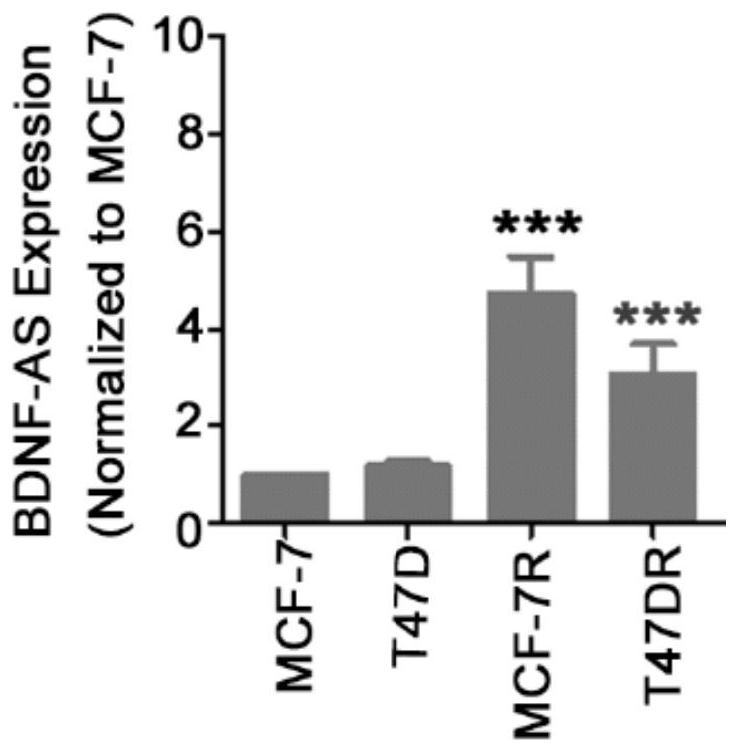Long non-coding RNA BDNF-AS and application thereof as marker and therapeutic target
A RNABDNF-AS, non-coding technology, applied in the field of long non-coding RNABDNF-AS and its application as a marker and therapeutic target, can solve problems such as overtreatment, lack of drug selection, and reduced patient compliance, and avoid Blind treatment, improve treatment effect, avoid the effect of over treatment
- Summary
- Abstract
- Description
- Claims
- Application Information
AI Technical Summary
Problems solved by technology
Method used
Image
Examples
Embodiment 1
[0035] qPCR detection of the expression of long non-coding RNA BDNF-AS
[0036] (1) Primer design: The sequence of the long non-coding RNA BDNF-AS was found from the gene library NCBI, and primers were designed with Primer software.
[0037] Forward: 5'-TCACATCTTAGCCCCTTAGCC-3' (SEQ ID NO:4)
[0038] Reverse: 5'-TTTAGCACCCAACAGAATCCC-3' (SEQ ID NO:5)
[0039] (2) qPCR detection (using conventional experimental conditions and steps):
[0040] The expression levels of long non-coding RNA BDNF-AS in breast cancer endocrine-sensitive cell lines and breast cancer endocrine-resistant cell lines were detected. Such as figure 1 As shown, MCF-7 and T47D are tamoxifen-sensitive breast cancer cell lines; MCF-7R and T47DR are tamoxifen-resistant breast cancer cell lines; The expression in the cell lines was significantly higher than that in the breast cancer endocrine-sensitive cell lines. BDNF-AS is specific, that is, based on the expression level of BDNF-AS, it can detect whether t...
Embodiment 2
[0042] In situ hybridization was used to detect the expression of long non-coding RNA BDNF-AS in endocrine-sensitive breast cancer and endocrine-resistant breast cancer.
[0043] Steps include:
[0044] S1. Prepare a tissue chip from the paraffin-embedded breast tissue, perform routine paraffin sectioning, dewax with xylene, and hydrate with gradient alcohol;
[0045] S2. Apply 0.05% trypsin to the section obtained in S1 at room temperature for 10 minutes to enzymatically digest the protein, then add 4% paraformaldehyde and maintain it for 20 minutes for fixation, and finally wash with PBS;
[0046]S3. Treat the slices in the pre-hybridization solution for 2 hours, discard the pre-hybridization solution, and incubate overnight at 52°C with 20nM probes; wash 2 times with 2×SSC for 5 minutes each time, and then wash with 50% formamide Wash 3 times with 2×SSC, 25min each time, and finally wash 5 times with PBST, 5min each time;
[0047] S4. Block with 10% normal goat serum at r...
Embodiment 3
[0051] In situ hybridization detection combined with clinicopathological data to analyze the relationship between long non-coding RNA BDNF-AS and tumor prognosis in breast cancer and the diagnostic efficacy of endocrine drug resistance in breast cancer.
[0052] Specifically, the result is as image 3 shown, where image 3 The left figure shows the efficacy of BDNF-AS in diagnosing endocrine drug-resistant breast cancer, and the right figure shows the correlation analysis between BDNF-AS and the overall survival rate of breast cancer (P value has statistical significance).
[0053] From image 3 (Right) It can be seen that in breast cancer, compared with the low expression group of long non-coding RNA BDNF-AS, the prognosis of the high expression group is significantly worse, and the survival rate of the high expression group is lower than that when the number of days is gradually increased. Fast, and the survival rate was significantly lower than that of the low expression ...
PUM
 Login to View More
Login to View More Abstract
Description
Claims
Application Information
 Login to View More
Login to View More - R&D
- Intellectual Property
- Life Sciences
- Materials
- Tech Scout
- Unparalleled Data Quality
- Higher Quality Content
- 60% Fewer Hallucinations
Browse by: Latest US Patents, China's latest patents, Technical Efficacy Thesaurus, Application Domain, Technology Topic, Popular Technical Reports.
© 2025 PatSnap. All rights reserved.Legal|Privacy policy|Modern Slavery Act Transparency Statement|Sitemap|About US| Contact US: help@patsnap.com



